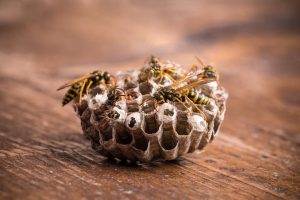
Most bee and wasp species, the latter of which include yellow jackets and hornets, are either solitary or semi-social insect species that use their stingers solely to paralyze their natural prey. Solitary bee species include mason, carpenter, leafcutter and mining bees. Solitary wasp species include cicada-killer, mud dauber and spider wasps, and they can be intimidating, as many species are large in size and possess a visible stinger. Luckily, solitary bees and wasps rarely sting humans, unless the insects are carelessly handled. However, this is not the case when it comes to social bees and wasps, which are the bees and wasps that most people are familiar with.
Social bees include the European honey bee and the potentially deadly Africanized honey bee, both of which are commonly spotted in Ventura County, and many honey bee specimens in the area are hybrids of the two species. Africanized honey bee attacks have occured in Ventura County, and their nests can be found on properties where they are often attached to structures. Removing honey bee nests from properties should never be attempted by non-professionals. Social wasp species include yellow jackets, and the non-native European hornet has been found in Ventura County.
Yellow jackets generally nest in burrows below the ground, but they are apt to attack humans when disturbed by lawnmowers or landscaping workers. Yellow jackets occasionally build paper nests in bushes, trees, garages, on homes, and in some cases, nests are found within doorways and inside of homes. When yellow jacket nests are found within high-traffic areas of a home, a pest control professional should be contacted for their removal. European hornets generally inhabit forested areas, but their nests have been found attached to porches and houses, and while they are not as aggressive as yellow jackets, they will not hesitate to attack humans when disturbed.
Unlike solitary bees and wasps, social bees and wasps use their stingers for defensive purposes, and not just for subduing prey. The nests built by social bees and wasps are guarded by several individual specimens that pose a threat to humans located within 7 meters of a nest, but encountering individual social bees and wasps away from their nest should not elicit concern.
Have you ever attempted to remove a bee or wasp nest from your property?


